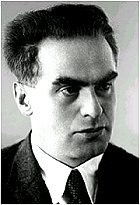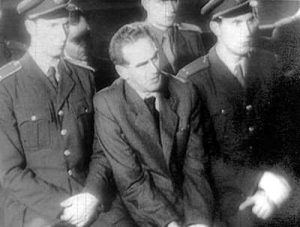Rudolf Slansky and the Slansky Trial
By Tracy A. Burns
Childhood and life through World War I
 This longtime Communist became the central victim of the purges that he helped orchestrate and was the most powerful politician executed during the totalitarian era in Czechoslovakia. Slansky was born in Nezvestice on July 31, 1901, when Czechs were subject to Austrian rule under the Habsburg Empire. The son of a Jewish businessman, Slansky attended a commercial academy in Pilsen (Plzen). After World War I, he made Prague his home, where he became enamored with leftist ideology.
This longtime Communist became the central victim of the purges that he helped orchestrate and was the most powerful politician executed during the totalitarian era in Czechoslovakia. Slansky was born in Nezvestice on July 31, 1901, when Czechs were subject to Austrian rule under the Habsburg Empire. The son of a Jewish businessman, Slansky attended a commercial academy in Pilsen (Plzen). After World War I, he made Prague his home, where he became enamored with leftist ideology.
Joining the Communist Party
In 1921, when democratic Czechoslovakia was only three years old, Slansky became a member of the Communist Party. In 1924 he held the position of editor of the Communist Party newspaper, Rude Pravo, and he rose in the ranks of the Party, serving as regional Party secretary in Ostrava and then a member of the Central Committee. Because the Communist Party was illegal in democratic Czechoslovakia from 1929 to 1935, Slansky was in hiding during those years. After the Party officially joined the Czechoslovak political sphere, he became a member of the National Assembly, along with colleague and friend Klement Gottwald. In September of 1938, things changed for the worst when the Munich Agreement was signed, and Czechoslovakia’s Sudetenland, where many German speakers lived, was ceded to the Third Reich.
Fleeing into the USSR
Slansky took refuge in the USSR, but other members of his family were not so lucky. They died in the Terezin concentration camp in central Bohemia. Even Moscow was not safe. During 1941 and 1942 Slansky survived the brutal Nazi attempt to take over Moscow, where he contributed to Czechoslovak radio broadcasts and participated in Czechoslovak Communist activities. It was in the Soviet capital that Slansky became acquainted with the Communist inclination toward brutality and torture. He was fully aware of the murderous methods used by Communists to punish those condemned. In 1943 he experienced tragedy when his daughter Nadia was kidnapped, and taken from her baby carriage. The reasons for the kidnapping are unclear. Neither Nadia nor the female kidnapper was ever found.
Back in Czechoslovakia
A year later Slansky came back to Czechoslovakia, fighting on the Ukrainian front against the Germans in the Slovak National Uprising of 1944, but the rebels were defeated. Slansky was a major player in orchestrating the February 1948 Communist coup that made Czechoslovakia a totalitarian country and served as general secretary. The diehard Communist was the second-in-command after President Gottwald.
The purge trials
After Yugoslavia broke away from USSR control, Joseph Stalin decided to send a message to the Eastern European bloc countries by purging the high-ranking Communist officers. The accused were tortured into confessing, and the trials were scripted, with lines memorized by the defendants. Orchestrated between 1948 and 1953, the trials were shown as the defendants were convicted the moment they were accused. Anti-Semitism played a significant role in the trials. The most extreme torture was inflicted on the highest-ranking Communist officials. Communists targeted Jews and officials who had contacts in the West, including those who had lived in exile in the West or had wives from western countries. Party members who did not have working-class backgrounds also became victims. Soviet advisors oversaw the setting up of the show trials.
The Slansky Trial
 Slansky was one of those in charge of purging two of his colleagues. Then, when President Gottwald suspected he might be purged, he decided to sacrifice his close friend Slansky, who was arrested with 13 others in November of 1951. Accused of being a traitor, spy, and saboteur, among other charges, Slansky was tortured in Ruzyne prison and forced to confess and memorize a script during the prominent show trial. All 14 of the accused confessed, and 11, including Slansky, received death sentences. Notably, 11 of the convicted were of Jewish origin. In desperation, Slansky tried to commit suicide twice in prison. He was hanged at Pankrac Prison in Prague on December 3, 1952. The public humiliation did not end with the victims’ deaths. Their ashes were dumped at a construction site near Prague.
Slansky was one of those in charge of purging two of his colleagues. Then, when President Gottwald suspected he might be purged, he decided to sacrifice his close friend Slansky, who was arrested with 13 others in November of 1951. Accused of being a traitor, spy, and saboteur, among other charges, Slansky was tortured in Ruzyne prison and forced to confess and memorize a script during the prominent show trial. All 14 of the accused confessed, and 11, including Slansky, received death sentences. Notably, 11 of the convicted were of Jewish origin. In desperation, Slansky tried to commit suicide twice in prison. He was hanged at Pankrac Prison in Prague on December 3, 1952. The public humiliation did not end with the victims’ deaths. Their ashes were dumped at a construction site near Prague.
Finally exonerated
When Stalin died in March of 1953, the strict USSR policy of purges weakened. The Slansky Trial victims were cleared of the charges in April of 1963. In May of 1968, they were rehabilitated and exonerated. However, political trials did not come to an end in Communist Czechoslovakia. Many innocent political prisoners were sentenced to death or wound up toiling in labor camps.
Legacy and son
The Slansky Trial has been the focus of books and a film. Rudolf Slansky’s son, also Rudolf, was a dissident during Communist rule, and when Vaclav Havel became president, he appointed Slansky Czech ambassador to the Soviet Union.




